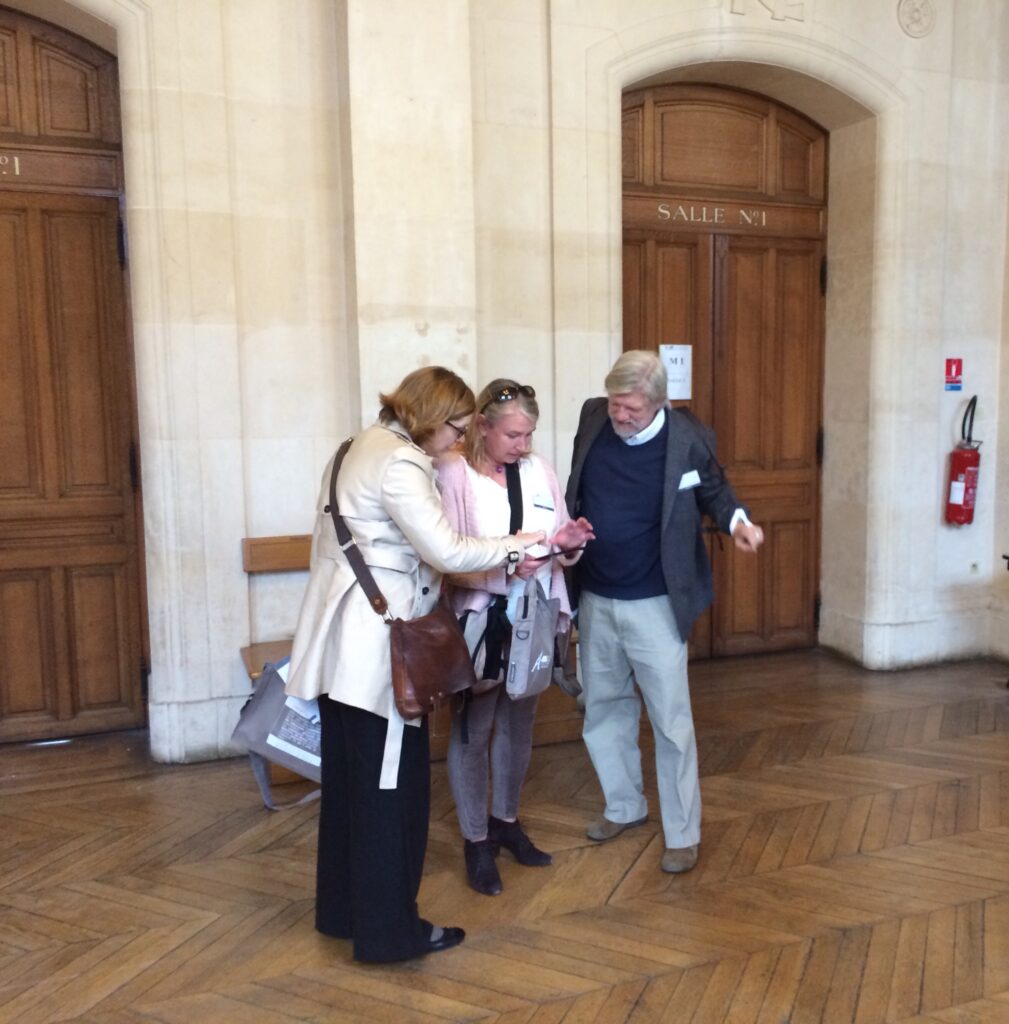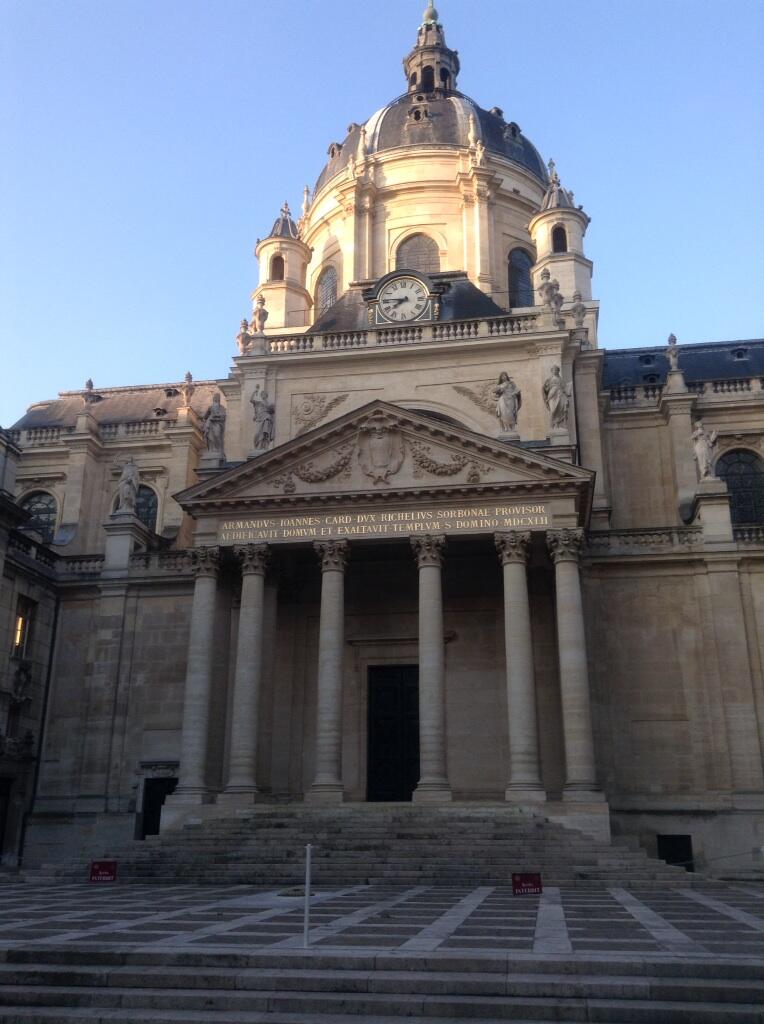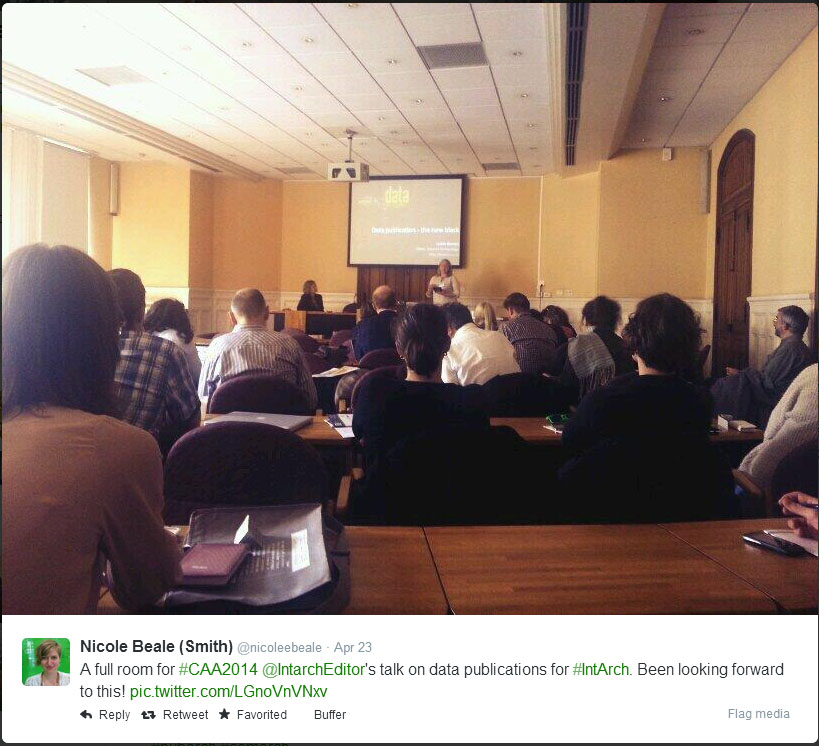The annual CAA (Computer Applications and Quantitative Methods in Archaeology) conference took place in the impressive surroundings of the Sorbonne. The Archaeology Data Service and Internet Archaeology were very well represented throughout the 4 days of the conference.

Day One 22nd April 2014
Partners from the ARIADNE project came together in Paris in the ARIADNE Workshop on On-line Resources chaired by ADS’s Catherine Hardman. The workshop introduced archaeological researchers to a variety of on-line data resources, including those held by the three partners providing on-line access to their data as part of the EC Infrastructures funded Advanced Research Infrastructure for Archaeological Dataset Networking (ARIADNE) project.
The partners were the Archaeology Data Service (ADS), ARACHNE at the German Archaeological Institute (DAI), and Fasti Online at the International Association of Classical Archaeology (AIAC). In addition to the ARIADNE partners, the workshop featured a presentation on data and data integration in the Digital Archaeological Record (tDAR). tDAR is an international digital repository based in America for the digital records of archaeological investigations.
A slight hiccup in room allocation made the first challenge one of getting the speakers and attendees together in the same room in the same building at the same time, although we chose to find the lack of AV equipment a situation full of Parisian charm!

ADS’s Michael Charno started the workshop with an overview of the work of the ADS with a special focus on the work they undertake to make the data they host freely and openly available for reuse, not only by individual researchers and users but other data providers. This really helps in the reach of the data that the ADS holds. The workshop found the approaches taken by the ADS to be interesting and effective.
Keith Kintigh from tDAR gave an interesting presentation on the work of this digital archive based in the USA. Keith gave an overview of the types of data that they accept and the organisations which which they work. Of particular interest to the workshop attendees was the innovative approach to deposition and charging that tDAR have implemented.
Jess Ogden from Fasti On-line gave a presentation to the workshop about the work her organisation undertakes and the bringing together of a wide range of the excavation information from across the ‘Roman’ world. Fasti on-line provides a database of excavations since 2000, providing a record in English and in the local language for each season. Each participating country is responsible for uploading the data it gathers and jess was able to provide a great illustration of what can be achieved when researchers use a common platform.
Marcel Riedel and Fabian Scheler from ARACHNE showed the workshop participants a resource based in Germany which provides archaeologists and Classicists with a free internet research tool for quickly searching hundreds of thousands of records on objects and their attributes, in both English and German. The number of images available is vast and the discussion among participants surrounded the challenges that were presented by delivering such large data sets in a useful fashion.
Day Two 23rd April 2014

After some opening speeches in the stunning Richlieu amphitheatre, the conference proper began.Internet Archaeology editor Judith Winters kicked off by chairing an all-day session on Strategy, Practice & Trends in Online Archaeology with Virginie Fromageot-Lanièpce from the CNRS. This was a popular session (nothing to do with the comfortable seats, we’re sure!) and had its own dedicated #caatrends hashtag on Twitter. The session explored how archaeologists are collaborating, implementing and using web-based technologies.
The morning session was devoted to the theme of open access: Alessandra Caravale and Alessandra Piergrossi on the long running open access journal Archeologia e Calcolatori; Doug Rocks-Macqueen on the fast-changing open access landscape (see Open Access Archaeology); then co-chair Virginie Fromageot-Lanièpce on EMA (L’Enfant et la mort dans l’Antiquité) a dual language database on child burials in antiquity, a fascinating collection on topography markers and tombs, graves and types of treatment of the body, offerings and other ritual practices.
Judith then presented a paper on the growing trend (“the new black”) of data publication, typified by Internet Archaeology’s own series of data papers, calling for us all to get used to citing data in the same way we cite journal articles, to give credit for those who make the effort to publish, archive and curate their data (perhaps with the end point being that we will no longer need data papers at all!).

After a double bill on impact and use of social media by Ingrida Vosyliute (Facebook as knowledge management tool) and Lisa Fischer (blogging, webcams and 3d modelling at Colonial Williamsburg, a brilliant use of social media to engage audiences even when they aren’t on site), it was the turn of ADS’s Catherine Hardman presenting on ADS easy, the ADS’s new online tool that allows depositors to estimate archiving charges and upload to the ADS repository. Catherine was followed by our colleagues Maurice and Felix from IANUS talking about resent developments as they build a national digital archive for archaeological and related data in Germany.
The afternoon session was more focused on GIS applications: Katherine Gruel (View and share geo-referenced data at different scales : Chronocarto), Susanne Rutishauser (Virtual Cilicia Project, using Google Earth as a visualisation tool for archaeology), Lionel Fadin from Ecole française d’Athènes on the web GIS development on the archaeological site of Delos and Alban-Brice Pimpaud on the GIS developed for Western Thebes. A varied but fascinating day and we were definitely ready for the cocktails by the time we finished at 6pm!
Day Three 24th April 2014
Thursday saw ADS Lead Application Developer Michael Charno give a paper in the Community Archaeology and Technology session chaired by Eleonora Gandolfi and Nicole Beale. This session addressed the viability and applicability of advanced technologies in recording, management and communication of cultural heritage, when working with communities.
Michael’s paper ‘Create Once Consume Anywhere: Curating Accessible Archaeological Content for Mobile Apps’ presented his experience of developing the general audience app Archaeology Britain, from the planning and inception to the release and promotion. ADS collaborated with the British Library to produce the app which portrays rarely seen perspectives of British archaeological sites. Michael presented the many challenges faced while trying to curate an app targeted at the general user instead of the more academic audience the ADS usually targets, as well as the fallout from the dissemination of the app (only for ios) which ranged from user exclusion to fanboy rage. Many of the lessons that were discussed by Michael aren’t specific to mobile apps, but apply generally to all forms of disseminating archaeological knowledge and information to the public.
Michael was preceded by the familiar voice of former ADS colleague Stuart Jeffery who introduced the AHRC funded ACCORD project, a partnership between the Digital Design Studio at the Glasgow School of Art (Stuarts new home), Archaeology Scotland, the University of Manchester and the RCAHMS, which examines the opportunities and implications of digital visualisation technologies for community engagement and research through the co-creation of three-dimensional (3D) models of historic monuments and places.
Day Four 25th April 2014
ADS Director Julian Richards began Session 1 of day four, Towards a History of Archaeological Computing, with a paper on the hot topic of ‘Open Data’ and the development of online data sharing in archaeology. The session Chaired by Paola Moscati and François Djindjian focused on the reconstruction of the progressive steps in archaeological computing over the last 50+ years, in order to shed light on the theoretical implications arising from the meeting between computer science and the humanities and the role played by information technologies for the development of archaeology.
Julian’s paper ‘The Development of Data Sharing and Open Data in Archaeology’ discussed the history of data preservation and access in archaeology, based on the experience of the ADS, and draw lessons on what worked, what didn’t work, and why, as well as providing some possible pointers for future directions.
You can still catch up with the conference by following the #caa2014 hashtag on Twitter or take a look at the tweet archive.
Our own Judith Winters @IntarchEditor was one of the the top tweeters!





